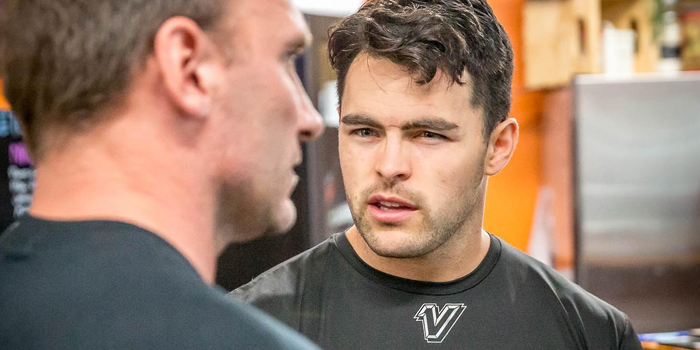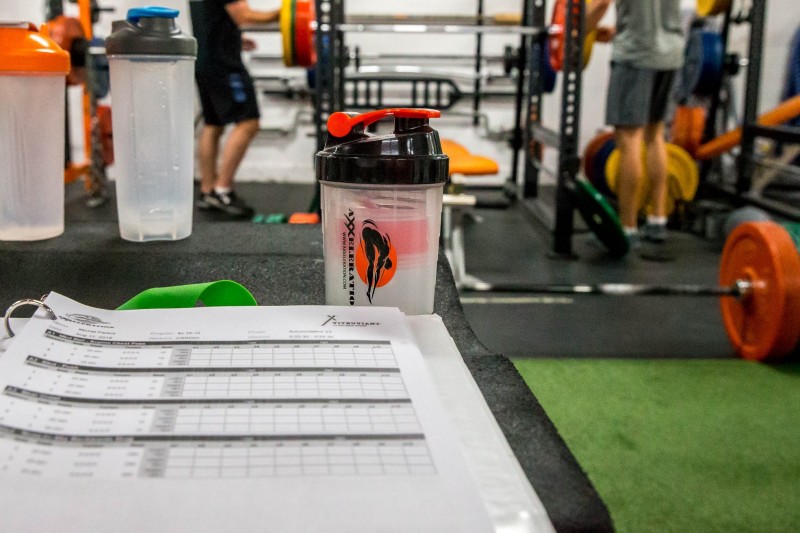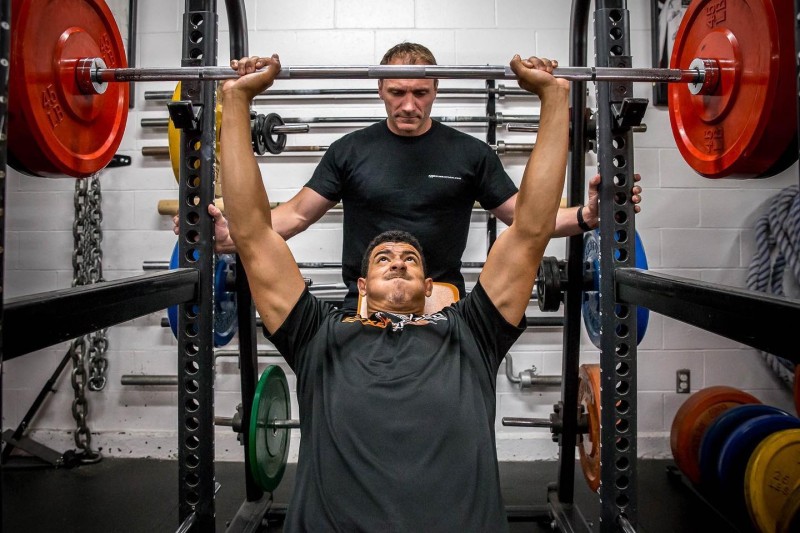
Once I heard Dave Tate talk about “perfect” programs on episode 44 of the Table Talk podcast, I knew I had to write this article. He mentioned reading a program or workout, saying to himself, “What the f*ck?” I know this feeling all too well since I’ve seen many programs or training plans that leave me scratching my head. Most of the time, it is either because I know the session will be WAY too long for who it is intended for or because I’m trying to figure out what the trainer is trying to work on. From my experience, if either of those two issues are present in a program, it will be very difficult to get an athlete to buy into the program. If an athlete doesn’t buy into it and give 100 percent effort towards it, results will be hard to come by.
First off, I would like to give all the credit to Stan Efferding for the article's title since it is one of the many phrases he uses when talking about the Vertical Diet. It is a very catchy phrase, but it’s also the truth, especially in getting results from training and dieting. I’ve FINALLY come to realize this now after almost a decade of training. It took some time, but better late than never.
MORE: The Integration of Unilateral and Bilateral Movements to Assist in Strength Development
What’s funny is that I always knew it. I just never REALIZED it. Years ago, when I had a trainer taking care of my programming and nutrition, I got amazing results. I was my strongest, heaviest, and leanest I had ever been. What was the secret? ADHERENCE to the plan. I ate the same way every day, trusted my coach 110 percent, and made sure to do the little things to train hard the next session. I had a passion for training, so it was easy for me to forgo having a social life (or life at all).

Once I started planning my own training and nutrition, results began to stop coming by, and I couldn’t figure out why. I was training hard (I would even say too hard) but without a plan. Whenever I would write something up, I would later read something online and question everything I had come up with. After a week, I would make changes to my program. I never forced myself to stick with the original plan long enough to see any benefits from it. Yes, I’ll admit, I was program hopping. I still have my notes and programs, and when I look at them, I realize now that had I kept with it for more than one to two weeks at a time, I would have gotten some results, even if it wasn’t the PERFECT program. After two years of doing this, I got ZERO results.
Then I stopped training for hockey and started training to get as big and as strong as possible. I had ZERO knowledge of how to approach my training because I was always in the mindset of sports performance, which is different from trying to lift maximal weights and looking like a block of muscle. I was struggling trying to figure out what to do because I wanted to do everything. I love high-intensity training, and the style John Meadows or Dr. Scott Stevenson preach. I also loved the feeling of getting under the bar while being uncertain of whether or not the weight would come up or crush me. One day though (Thank God!), I got an email from Ben Pollack saying he was taking on some new online clients. I emailed him right away. It was a Godsend, and I couldn’t pass up on the opportunity. His goals with training are very similar to mine, so I knew he would know what I should do. I’m very fortunate to have him as a coach now. Just from the first cycle, I added 65 pounds to my deadlift (435 to 500), 45 pounds to my squat (425 to 470), and 25 pounds to my bench (235 to 260), not to mention I’ve added a lot of muscle.
Besides the excellent programming and coaching, what was the secret? ADHERENCE. I followed Ben’s plan to a tee and stuck with my diet for the last 3-4 months. Even though I would want to do extra or think the weight was too light, I reminded myself that Ben prescribed the weights and the amount of volume for a reason. It sounds a bit odd, but I just threw everything I knew and all my experience out the window. If I sensed something is really off, I would let Ben know, but besides that, I trusted his judgment and waited to see how things unfolded. It’s a good thing I didn’t sabotage the plan, or else I might not have gotten the same results.
Besides being an athlete, I’m also a coach. I will soon be embarking on another challenge. I will be making sure the plan is enforced and my athletes comply with what I give them.
Next year will be my first year as the head strength coach for a team. I am very fortunate to have the chance to work with a professional hockey team in France. To make the situation a little more challenging for me, I won’t be in France full time because I’ll be finishing my undergrad at McGill University in Montreal. I’ll essentially be an online trainer for the team, with the occasional visits during the pre-season and season.
I’ve learned from being a competitive hockey player that, on average, less than 50 percent of the guys on a team will actually train consistently during the season. It has been proven over and over again that in-season training to prevent muscle mass and strength loss correlates to decreased injuries. Unfortunately, many athletes are worried about being too tired or sore for their practices and games. And you know what, I don’t blame them! I’ve been on some teams where the training would leave you feeling sore for game time. Luckily for me, the training wasn't enforced, so I could do my own program. The vast majority of my teammates wouldn’t even enter the gym because they were either scared or didn’t believe in the program.

Without going into details about the programs, the major issues I saw with the programs were that they were too long and had way too much volume. If you ask a collegiate athlete to do a two-hour workout full of supersets before or after practice when they have two games on the weekend, you probably won’t get the nicest of responses from them.
So I wonder, what’s the point of putting all that work into thinking and planning an in-season program if 90 percent of the people aren’t going to do it? Not only will the athletes suffer and be more susceptible to injuries, but there’s the potential of losing trust and respect from the athletes. If the athletes CAN’T comply with the training, it’s a lose-lose situation.
What will make working with the team in France a little tricky is that I won’t be at the rink every day to get constant feedback from the players to determine how and if they should train that day. I’m a little more instinctual during the season and base the day's work primarily on body language. If the guys come into the gym with their hands in their pockets and bags under their eyes, it might not be the greatest idea to have them do heavy squats, or even train at all. I’m currently working on the details of my plan of attack, but my goal is to get the players to AT LEAST do something in the weight room. I will be giving them some wiggle room to let themselves autoregulate, but I will be asking them to give me at least a little bit.
Let’s say one of the guys is pretty tired from playing a lot of minutes on the weekend; it’s up to him if he wants to do the main lift or focus on accessory work that day, with both being on the lower weight end. He’ll be in and out of the gym in no more than 30 minutes, including his warm-up. The worst-case scenario is that the player is so beat up that he does a little 15-minute recovery session with bands before practice as his warm-up. It all depends on the situation, but the key is knowing the athletes and how they are feeling to adjust the plan from there.
I believe that compliance starts with the coach. He or she needs to know the athlete they’re working with.
What kind of training do they like?
How much time are they able to train for?
This does not only apply to athletes. Try telling a mom of two young kids and working a full-time job that wants to lose weight that she needs to do cardio in the morning and at least four weight training sessions a week. Unless she’s Super Woman or very motivated, it’s doubtful she’ll be your client long enough to see the weight come off.
I’m not saying completely ditch your training philosophy or knowledge. Like Jim Wendler has mentioned before, it’s about “knowing the trapdoors of your program." I believe being a good strength coach is being able to adjust and tailor your training philosophy to the needs and preferences of your athlete. You may have all the knowledge in the world, but without your athlete’s trust and willingness to comply with the program, it will be very hard to get results.
Max Daigle is currently finishing his undergrad at McGill University in BSc. Physiology, with a Minor in Kinesiology. He played NCAA Division 1 hockey at the University of Vermont before transferring to McGill, where he played two seasons. Max is the assistant strength coach at Axxeleration Performance Center, under the mentorship of Mark Lambert (Head Strength Coach Tampa Bay Lightning NHL) and Sebastien Lagrange. Axxeleration Performance Center is a private gym just outside Montreal, Quebec, that works primarily with hockey players.











I worked with figure skaters in the same rink who would absolutely never complain about training.
This is the solution you offer to the problem stated... "I believe that compliance starts with the coach. He or she needs to know the athlete they’re working with."
What new knowledge did I gain from taking the time to read this? I learned about your anecdotal experience as an athlete.
I'm sorry the title deceived you! The article was not meant to provide science. The phrase "Compliance is the Science" is something I got from Stan Efferding (Vertical Diet) and he uses the catchy phrase to teach people the importance of following a plan.
What I meant to show in the article was that being able to comply and stick to a plan (training or diet) you CAN FOLLOW on a long-term basis will yield better results than flip-flopping between different programs (or worse, not doing anything!).
Think about this. Is it better for an athlete to follow a B+ program for 52-weeks or for them to follow an A+ program for 3-weeks before deciding they don't like it and want to switch?
It took me a long time of no progress to realize this...